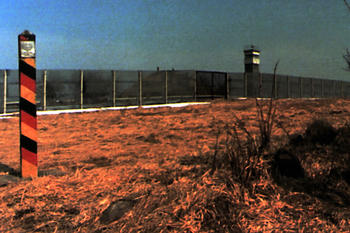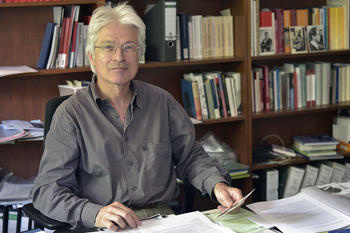Keeping Memory Alive
Research project at Freie Universität presents victims of the East German border regime and their biographies; commemorative book currently being prepared
Sep 12, 2016
People were killed during attempts to cross the border between East and West Germany. Their biographies have now been studied at Freie Universität.
Image Credit: CC0: Wikimedia Commons
Jochen Staadt of the research alliance Forschungsverbund SED-Staat and his colleagues are studying the biographies of victims of the East German border regime.
Image Credit: Manuel Krane
In February 1987, restaurant operator Detlef Armstark, then 26, had run up so much debt that the East German state-owned wholesale company no longer wanted to deliver to him. He was also listed by the East German secret police, the Stasi, in their “Vorverdichtungs-, Such- und Hinweiskartei” (literally “pre-compilation, search, and reference file”), which contained information on certain individuals. Armstark was convinced that he no longer had a future ahead of him in the German Democratic Republic, so he decided to flee.
In Wittenberge, where the Elbe River did not yet mark the border between the two countries, he took the plunge, setting off on the water one night. He had tied two air mattresses together and was counting on the current to carry him downriver toward the state of Lower Saxony, in West Germany. But Armstark never made it to the other side. His vessel capsized, and he drowned. The next day, an East German border patrol boat found his body in the Elbe, near the East German town of Lenzen.
Armstark was one of many victims of the East German border regime who were previously not counted as such. Now, all that is about to change. Jochen Staadt and Klaus Schroeder of research alliance Forschungsverbund SED-Staat at Freie Universität are working to ensure that these people’s fates are not forgotten. In a project titled “The Victims of the East German Border Regime on the Border between East and West Germany,” they have researched the life stories of a large number of people who were killed on the border. The research project is receiving support from the German Federal Government Commissioner for Culture and the Media and from the states of Saxony-Anhalt, Lower Saxony, and Hesse.
After the GDR ceased to exist as a country, a new body called the Zentrale Ermittlungsstelle Regierungs- und Vereinigungskriminalität (Central Office for the Investigation of Governmental Crime, or ZERV) was formed. It logged information on about 400 deaths that had occurred on the border between East and West Germany. However, the ZERV only documented cases in which the death was caused directly by outside forces, such as use of weapons. These cases were important from the standpoint of criminal law. Following German reunification, there were a number of cases in the 1990s in which former East German border patrol officers and their commanding officers were prosecuted for crimes. Deaths not caused directly by outside forces were not included. “That means, for example, when people drowned while attempting to flee, like Detlef Armstark did,” explains Staadt, a historian.
More than 1,400 Suspected Cases
The team from the research alliance investigated more than 1,400 suspected cases. The researchers’ count of the victims also includes people who inadvertently wound up in the border zone and then lost their lives. “That includes both West Germans and East Germans,” Staadt says.
Staadt and Schroeder got the idea for their research project when similar documentation was published regarding the victims of the Berlin Wall. “We thought it wasn’t enough, and that instead, someone should see how many people had fallen victim to the East German border regime in total,” says Staadt. “And that, of course, also includes the people who lost their lives along the 1,400-kilometer border between East and West Germany.”
Victims include Border Patrol Officers
The research group has even included some East German border patrol officers in their count of the victims. “Not everyone was a true believer. Far from it, in fact,” Staadt says. “Young people were forced to serve on the border even though they had already said during their initial physical that they didn’t want to do so,” he explains. To secure the border with West Germany, East Germany needed 30,000 to 40,000 soldiers. They were selected according to stringent criteria and monitored by the Stasi to keep less willing recruits and those who were considering fleeing the country from using their positions on the border to escape.
Despite the stringent selection, Staadt explains, many soldiers still had a negative attitude toward their service. “Many of them had a problem with having to shoot at civilians in case of doubt. They wanted to use their weapons for self-defense only,” he says. The result was that soldiers asked to be released from serving on the border and were subsequently transferred. Anywhere from 500 to 1,000 young men were removed from the border service this way each year. “As a result, the border patrol service constantly had staffing issues,” explains Staadt.
The research team found that the majority of those killed trying to flee the country were young men under the age of 25. This group accounted for about 70 percent of the refugees. In addition, most of the victims were laborers, blue-collar workers, or agricultural workers. There were very few among them who had obtained a higher education. “The irony of the story is that the very people who were making these dangerous escape attempts were those whose social status supposedly made them the ruling class in East Germany,” Staadt says.
Commemorative Book Being Prepared
All of the documented cases are now being compiled into a single biographic commemorative book. Alongside information on the circumstances of each person’s death, the authors also plan to include reports on the victims’ life stories. “Our goal is to introduce the subjects this way, recalling them as they were,” Staadt says. To that end, the research team reached out to family members of victims of the East German border regime to ask them about their personal recollections of the relatives or friends who had been killed. This allowed the researchers to correct a great many errors and misrepresentations that had been contained in the East German records.
About 260 of the biographies that have already been fully researched have been published on the research project’s website. In some cases, family members contacted the scholars after hearing about the site. Most of them, Staadt says, are “grateful and pleased that the memory of their relatives or friends is being kept alive in the public consciousness.”


